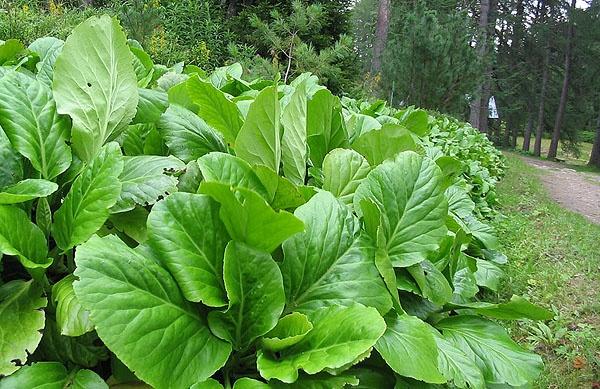
Here we will tell you about how we decided to make a separate bed in our garden specifically for planting badan. Fortunately, it is unpretentious and suppresses all the weeds around. And after the winter, the overwintered leaves are collected, well washed, dried and placed in canvas bags. And my whole family likes to drink a flavorful and healthy drink.
Bargenia is an evergreen perennial of the saxifrage family, which is not only medicinal, but also decorative value.This plant is named after the German physician and botanist Karl Bergen.
Features
Bargenia glorious bright inflorescences are small cup-shaped flowers located on leafless stems. Each inflorescence contains up to 120 flowers with a diameter of 2 cm (0.8 inch) each. And its large, shiny leaves are gathered in a rosette shaped like an elephant’s ears. Therefore, it is often called “elephant ears”. Bargenia badan brings a unique “flavor” to the architecture of the garden. In landscape design, it is indispensable in compositions of narrow-leaved and variegated plants. It looks very impressive against the background of water and rocks.
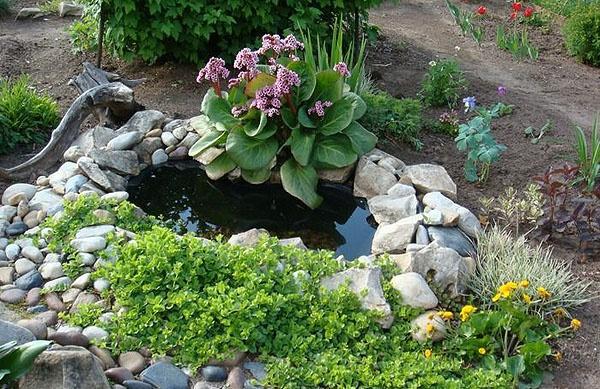
It is found in nature in 10 types of badan, of which many varieties are cultivated for garden cultivation. The place was chosen in the nearby groves of fruit trees. Bargenia badan does not tolerate open sunny places, in such conditions its development slows down.
The unique healer likes loose, light, slightly alkaline and moist soil, because it has a weak root system. Its thick horizontal roots are very close to the surface, so it is impossible to prevent the soil from drying out and becoming saturated. Indeed, in its natural habitat, roots protected by dead leaves naturally mulch the ground, retaining moisture during the dry months and protecting the soil from waterlogging during the rainy season. In gardens, for aesthetic reasons, old leaves are removed (or collected as a medicinal substance), and the roots are left without natural protection.
However, badan grows so much that some of its shoots, planted nearby, in 2-3 years after planting, completely cover the soil. From the small adventitious roots of the mother rhizome, many silky evergreen leaves grow. So in the beds with badan weeding you are not in danger, its intensive growth it clogs all the weeds.
In late April or early May, it begins to bloom and pleases the eye with its delicate inflorescences until the end of June. Its fragrant pink, purple, white or bright red flowers, like bright bursts, rise above the lush decorative rosettes of leaves. And in the fall, the leaves turn a bright bronze or purplish-brown color, which persists until spring. Sometimes the plant presents gardeners with a pleasant surprise – it blooms again in August or September.
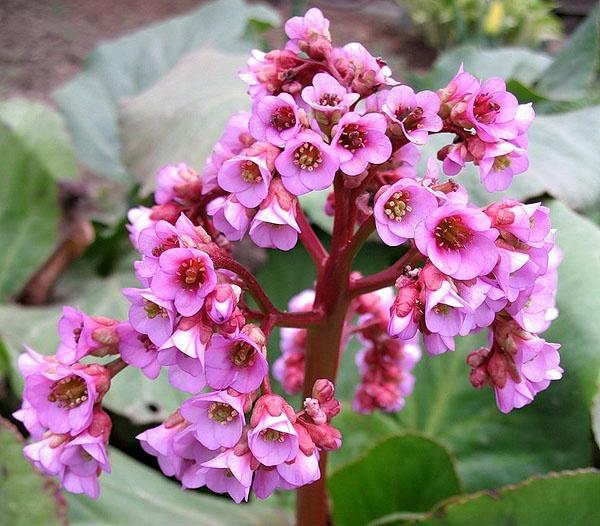
Reproduction and Planting
The plant is propagated by seeds or by dividing the bush.
Planting from Seeds
In early March, we bought land for flowers, covered it in a wooden box 50 x 70 cm (1.6×2.3 feet), made grooves at a distance of 3 cm (1.2 inch) from each other to a depth of 0.5 cm (0.2 inch) and then carefully poured them with warm water. Do not plant the seeds tightly and place the box in partial shade on the porch, maintaining a temperature of 18-19 °C (64-66 °F). Periodically watered. After 3 weeks, the first shoots have already sprouted, and a month later I have already got rid of the weeds. Seedlings are planted on the bed in early June.
We made holes with a depth of 6 cm (2.4 inch), placing them in a staggered order with a size of 40×40 cm (1.3×1.3 feet). At the bottom of each hole, sand is poured, the seedlings are carefully laid and covered with a soil mixture: 2 parts of loam, 1 part of humus, 1 part of loamy soil, 1 part of sand. My plant developed very slowly: it had only two leaves and shoots left for the winter. So what happens when you propagate saxifrage seedlings. Propagation of badan seeds in the first year should be covered with fallen leaves or peat. In the following years, the unique doctor needs mulching. Flowering occurs 3 or 4 years after planting.
Propagation and Planting by Dividing the Shrub.
Reproduction of badan by dividing the bush is not difficult. Because, when growing, the new roots will lie close to the ground, pushed out by the parent rhizome, and they are very easy to dig up without damaging the main root. Reproduction by dividing the bush is carried out in May – June. Each separated root should have root buds (at least 3) and 2-3 leaves. The separated parts are planted in prepared pits to a depth of 10-15 cm (3.9-5.9 inch), located at a distance of 30-50 cm (1-1.6 feet) from each other. After planting, watering the land is required. The division of badan shrub is recommended to be carried out no more than once every 4-5 years. Keep in mind that the plant grows up and out, so don’t save space.
Care for Bergenia
Taking care of badan is not a problem. In the fall, dry buds should be removed, and in the spring, the overwintered leaves should be cut off. In the first season after planting badan (whether seedlings or dividing the bush), the land should be mulched. It should be watered only as needed, avoiding drying out of the soil. The medicinal plant is responsive to the introduction of mineral fertilization. In the spring, you can feed it with a universal fertilizer, and in the fall, water it with a solution of superphosphate fertilizer at the rate of 20 g per bucket for watering 1 sq. m of soil.
When taking care of Baden, keep in mind that he does not like to change, and he is able to live in one place for more than ten years.
Types and Varieties
We have collected for you three best Bargenia badans options that are perfect for both the garden and other areas near your home.
Bergenia crassifolia

Bergenia crassifolia up to 50 cm (1.6 feet) in height, it has dark pink buds and fragrant flowers, framed by shiny light green leaves that change their color to red-brown with the onset of autumn.
Bergenia pacifica
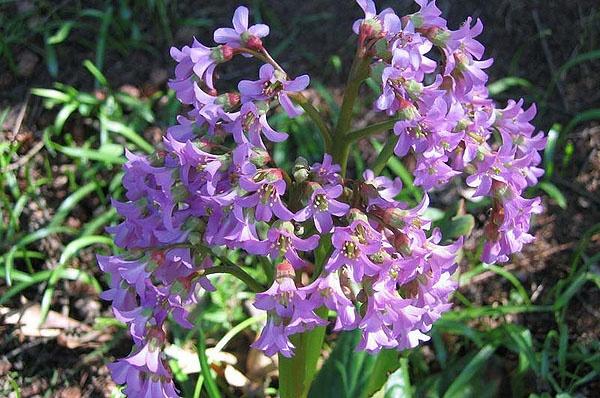
Bergenia pacifica it blooms with bright flowers with a pale lilac hue. The flowers are very similar to bluebells. It has large rounded leaves up to 20 cm (7.9 inch) in diameter.
Bergenia cordifolia

Bergenia cordifoli the height varies from 20 to 40 cm (7.9-15.8 inch) and depends on the growing conditions and the plant variety. The inflorescence is white, pink, purple or purple in color, framed by lush heart-shaped leaves, for what it is called heart-shaped.
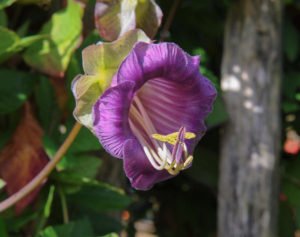
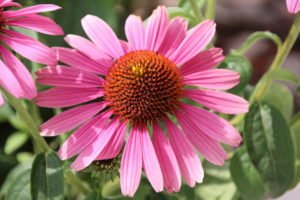


Leave a Reply